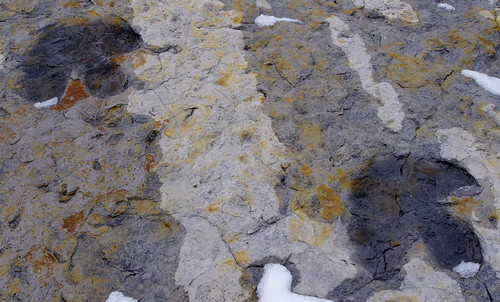In Morrison, Colorado, at the foothills of the Rocky Mountains, you can view traces of dinosaurs in one of the world’s most famous dinosaur fossil locations - a National Natural Landmark known as Dinosaur Ridge. Visitors will find tracks, known as trace fossils, and bones of dinosaurs, which are called body fossils.

At Dinosaur Ridge, layers of rock have been uplifted, exposing rock millions of years old that formed in a completely different environment than is found in Colorado today. The fossils have been exposed by the folding and faulting of what were once flat layers of sediment that piled up under water on the edge of a shallow sea. The footprints of the dinosaurs were made in a muddy environment of just the right consistency, then dried out and then filled with new sediment. Dinosaur bones would have also been sealed and trapped between layers of sediment that then compressed into rock over time. When the Rocky Mountains formed, the layers of rock were pushed into their current angled position.
The first stegosaurus fossils come from this location. What’s interesting, but not surprising, is that when Charles Marsh discovered the fossils in 1877, he had no idea how the plates and spines were oriented on the animal. He thought the plates of the Stegosaurus laid flat, like shingles on a roof, and the remains were from an aquatic turtle-like animal. It wasn’t until many years later, when more complete specimens were found, that scientists began to figure out that the plates were oriented vertically down the back and that the spines were most likely on the tail - the outline we’re so used to seeing. Scientists today don’t even agree on the function of the spines…were they for display or used for defense as a weapon? Eighty remains of Stegosauri have been found at Dinosaur Ridge. As a result of some persistent Girl Scouts petitioning across the state, the Stegosaurus became the state fossil in 1982.
By studying the many tracks found on Dinosaur Ridge - there are over 300 - scientists have learned that dinosaurs traveled together, in groups (at least mothers and their young), along defined routes. Tracks indicate dinosaurs may have migrated hundreds of miles along the coastal environment of the inland sea, as their footprints exist in what is called the Dinosaur Freeway - a band of tracks which stretches from Colorado to New Mexico.
A great place to learn more about the history and discovery of dinosaurs in Colorado can be found in the Dinosaur Hall of "Prehistoric Journey" at the Denver Museum of Nature and Science. Colorado is one of the leading states for dinosaur fossils. Along with the first Stegosaurus, the first Apatosaurus and Allosaurus were found in this area.
New information is being discovered every day as new fossils are uncovered. There are still questions to be answered by future paleontologists not only about stegosauri, but about other dinosaurs as well.
Sydney Kahl is a member of the Youth Travel Blogging Mentorship Program
Photo courtesy and copyright Sydney Kahl
